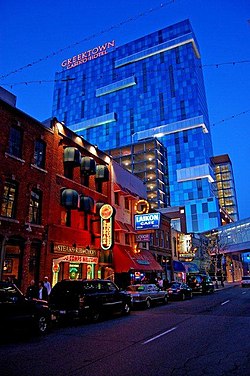Greektown, Detroit
Greektown Historic District | |
 Greektown at night | |
| Location | Detroit, Michigan, U.S. |
|---|---|
| Coordinates | 42°20′6″N 83°2′32″W / 42.33500°N 83.04222°W |
| Architect | Multiple |
| Architectural style | Late Victorian, Renaissance, Romanesque |
| NRHP reference No. | 82002902[1] |
| Added to NRHP | May 06, 1982 |
Greektown is a
Named for the historic Greek immigrant community of the early 20th century, the district still has Greek-themed restaurants. Notable buildings include
History
The area known today as Greektown was first settled in the 1830s by German immigrants, who created a primarily residential neighborhood in the area.[3] However, in the earliest years of the 20th century, most of the ethnic German residents, who had gotten established in the city, began moving from the neighborhood into newer residential areas farther from downtown.[3] As they left, a new wave of Greek immigrants moved into this older housing. Theodore Gerasimos was the first documented Greek immigrant in Detroit.[3] The newly arrived Greeks soon established their own businesses in the neighborhood.
By the 1920s, the area was developing more commercial structures, and the Greek residents began moving out in turn to newer housing. But the restaurants, stores, and coffeehouses they established remained.[3] The next thirty years brought a melange of immigrants to the few residential spaces left in the neighborhood. Redevelopment in the 1960s led to the neighborhood becoming the site of new municipal buildings and parking.[3]
Realizing the culturally significant neighborhood was at risk, Detroit's ethnic Greek leaders banded together. With the help of the Mayor's office, the streetscape and building exteriors were improved, and additional street lighting was installed.[4] The neighborhood threw a Greek festival in 1966, timed to coincide with Fourth of July celebrations.[4] The festival was a success, and was continued for years until turnout grew too large.[4] By that time, Greektown was firmly established in Detroit. The Greektown Historic District was listed on the National Register of Historic Places in 1982.

Changes continue, and as of June 2012 only three full-fledged Greek restaurants remain in Greektown.
In popular culture
Greektown is featured in the video game
In the American cable TV series Low Winter Sun (2013), the Detroit Police precinct is located four blocks from Greektown. Maya and Damon "kick up" tributes from her bar and from their drug and prostitution earnings to Skelos, Greektown's main crime lord. Seeking to gain independence from Skelos, Damon opens a blind pig outside of Greektown, where he kicks up to Reverend Lowdown (season 1, episodes 3 and 4).
See also
- History of the Greek Americans in Metro Detroit
- Greektown station
References
- ^ a b "National Register Information System". National Register of Historic Places. National Park Service. April 15, 2008.
- ^ "Detroit Greek Independence Day Parade". www.greekparades.com. Retrieved May 19, 2021.
- ^ a b c d e "Greektown Historic District". National Park Service.
- ^ a b c "Greektown history". Greektown casino.
- ^ Allan Lengel (June 24, 2012). "The Greektown We Knew is Gone". Deadline Detroit.

